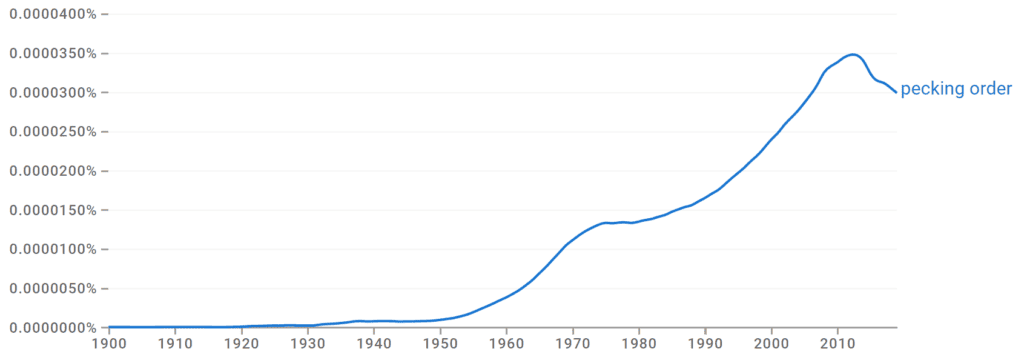The term pecking order was first used as a scientific term to describe the literal “hen pecking” of one another in a barnyard full of poultry. Today, the term is applied in a figurative sense to create an allusion and offer a passing opinion on a social situation.
Let’s take a closer look at the interesting origins behind this term and how you can use it in your speech and writing.
What Is the Meaning of a Pecking Order?

The dictionary definition of a pecking order first explains the term as a pattern of social organization within a poultry flock. In groups of hens, there is a hierarchical social system in which each bird is ranked in order of dominance. The top bird is permitted to peck all lower birds, while the second highest bird is allowed to peck all the birds below her, and so on.
For example:
- The addition of new hens to the coop changed the dynamics of the pecking order, placing them directly under the protection of the rooster, which ruffled the feathers of some of the older girls.
- My old hen is starting to slip down the pecking order and is no longer roosting towards the top of the coop; her perch seems to have been taken over by a younger group of hens.
However, the term pecking order has taken on a broader definition to explain a hierarchy of dominance among any social group of animals, including humans.
In business, for instance, the owner of a company is at the top of the pecking order, followed perhaps by the manager, then the assistant manager, then the worker most favored by management, and so on.
Many people argue that an organization isn’t required to witness a pecking order and that all human groups have a degree of social hierarchy occurring at all times.
For example:
- The school system, in recent decades, has become more a victim of political pecking order than exhibiting a good learning environment, but our new administration hopes to change that.
- In the pecking order of high school football, it was rare to watch a freshman start on the varsity team. However, the kid’s raw talents couldn’t be ignored, and his humbleness endeared him to even the oldest and most weathered players.
Pecking Order, Peking Order, Packing Order, or Peaking Order?
The phrase is occasionally misspelled in various ways, including packing order, peking order and peaking order, none of which makes logical sense.
Only use pecking order, as all others are wrong and nonsensical.
Pecking Order Origins

In the 1920s, a young man named Thorleif Schjelderup-Ebbe immersed himself in the observations of a barnyard full of chickens while on vacation with his parents. He was fascinated with their behaviors. By the time he was 10, he was filling notebooks with descriptions of the social statuses he witnessed within the flock.
Through the years, he grew and became an expert in the social hierarchies of domesticated fowl and many other bird species. His research has been applied to various other social organisms, including humans.
Let’s Review
Although pecking order first came about as a term to describe the behaviors of a flock of barnyard hens, the term has been used through the years in application to many other animals and the social behaviors of humans.
The phrase described the patterns of social organization based on behaviors. In chickens and other fowl, those behaviors are seen through literal pecking at or towards others. Other animals may exhibit various signs of their dominance other than pecking, such as vocalizations and other movements.
Humans, in particular, are incredibly complex, and when the term pecking order is applied to something, it means that there is an observation of hierarchy among that group.
